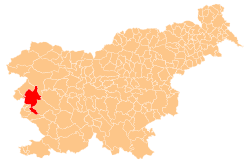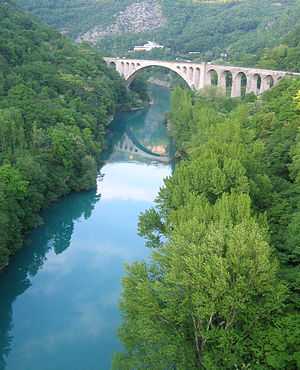Nova Gorica
| Nova Gorica | |
|---|---|
| Town and Municipality | |
 | |
 Location of the Municipality of Nova Gorica in Slovenia | |
_location_map.svg.png) Nova Gorica Location of the Town of Nova Gorica in Slovenia | |
| Coordinates: 45°57′21.18″N 13°38′35.67″E / 45.9558833°N 13.6432417°ECoordinates: 45°57′21.18″N 13°38′35.67″E / 45.9558833°N 13.6432417°E | |
| Country |
|
| Government | |
| • Mayor | Matej Arčon (independent) |
| Area | |
| • Total | 309.0 km2 (119.3 sq mi) |
| Population (2002)[1] | |
| • Total | 32,763 |
| • Density | 110/km2 (270/sq mi) |
| Time zone | CET (UTC+01) |
| • Summer (DST) | CEST (UTC+02) |
| Website |
www |
Nova Gorica (pronounced [ˈnɔ̀ːʋa ɡɔˈrìːt͡sa];[2] population: 13,852 (town); 21,082 (incl. suburbs); 31,000 (municipality))[3] is a town and a municipality in western Slovenia, on the border with Italy. Nova Gorica is a new town, built according to the principles of modernist architecture after 1948, when the Paris Peace Treaty established a new border between Yugoslavia and Italy, leaving nearby Gorizia outside the borders of Yugoslavia and thus cutting off the Soča Valley, the Vipava Valley, and the northwestern Karst Plateau from their traditional regional urban centre. Nova Gorica is the principal urban centre of the traditional region of Goriška in the Slovenian Littoral.[4]
Since May 2011, Nova Gorica has been joined together with Gorizia and Šempeter-Vrtojba in a common trans-border metropolitan zone, administered by a joint administration board.[5]
Name

The name Nova Gorica means 'new Gorizia'. However, the origin of the name Gorizia/Gorica itself is Slavic. The common local term for the town is Gorica (i.e., 'Gorizia'), while residents tend to refer to the neighboring Italian town as Stara Gorica 'old Gorizia'. This use is also reflected in Slovenian license plates (GO for Gorica), as well as in the name of the local association football club ND Gorica. The word gorica is a diminutive form of the Slovene common noun gora 'hill'. In archaic Slovene, it also meant 'vineyard'. It is a common toponym in Slovenia and in other areas of Slovene settlement.
History
In 1947, following World War II, Italy signed a peace treaty with the Allies, including Socialist Yugoslavia. The treaty transferred most of the Slovene-inhabited areas of the Italian Province of Gorizia to Yugoslavia. The town of Gorizia, itself, however, remained under Italian rule. The new border was drawn in a way that cut the city off its north-eastern surroundings, and left around 40% of the territory of the municipality to Yugoslavia, including the suburbs of Solkan, Šempeter, Kromberk, Rožna Dolina, and Pristava. The Communist authorities of the Socialist Republic of Slovenia therefore decided to build a new settlement in the area just along the new border, linking the former suburbs of Gorizia into a new urban space, named Nova Gorica or New Gorizia. The first projects were laid out in late 1947, and the construction began at the beginning of the following year. The urban project for the new town was designed by the architect Edvard Ravnikar, who envisioned a town built according to the principles of modernist architecture, following the visions of the French architect Le Corbusier.

The city was formally established as an urban municipality in 1952, and it incorporated the much older settlements of Solkan, Kromberk and Rožna Dolina, turning them into suburbs of the new town. The building of the town continued throughout the 1950s and 1960s, and it reached the current extension by the late 1970s and 1980s. In the early 1990s, all the aforementioned older suburbs acquired again the status of independent settlements. This was a purely symbolic act that only affected the official statistics on population: because of this formal act, Nova Gorica dropped from the list of 10 largest towns in Slovenia. In nevertheless remains the second largest urban conglomeration in western Slovenia, after Koper.
Culture and education
Nova Gorica hosts one of the four national theatres in Slovenia. The Museum of Goriška is also located in the town's Kromberk district, hosted in the Kromberk Castle.
The University of Nova Gorica is located in the suburb of Rožna Dolina. The Nova Gorica Grammar School, located in the city centre, is one of the most renowned high schools in Slovenia.
Nova Gorica hosts one of the 9 professional theatres in Slovenia, and one of the three to hold the title "National Theatre". It is considered as one of the best in the country.
Kostanjevica Hill
To the south of the town stands Kostanjevica Hill, home to the Church of the Annunciation of Our Lady and a 17th-century Franciscan monastery with rich treasures from the past.[6] The last members of the Bourbons, the French royal family, are buried in a crypt beneath the church (Charles X himself, and members of his family and entourage including his son Louis-Antoine de France, and his grandson Henri d'Artois, nephew of Louis (neither Louis-Antoine nor Henri ever reigned as kings)). He fled France following the revolution in 1830, finding refuge in Gorizia, and eventually eternal peace. Also buried there is Pierre Louis Jean Casimir, a Bourbon nobleman who also died in exile (in 1839).[7]

Sveta Gora
Opposite Kostanjevica Hill, north of the town is Sveta Gora (Holy Mountain), a peak of 682 m that has attracted pilgrims for 450 years. The view from there is exceptional, and on a clear day visitors can see as far as Istria, Venice, the Dolomites, and the Kamnik and Julian Alps. The mountain top is home to a magnificent basilica, where concerts are occasionally held, a Franciscan monastery, and a museum of the Battles of the Isonzo.
Politics
The municipality of Nova Gorica is governed by a mayor, elected every 4 years by popular vote, and a City Council of 32 members. Both in local and national elections, Nova Gorica has been considered an electoral stronghold of the left, in particular of the Social Democrats. Between the early 1990s and the mid-2000s, the two major political parties in the town were the Social Democrats and the Liberal Democracy of Slovenia, both considered as center-left parties. Since 1994, these two parties have been alternating in power on the local level, running candidates against each other and forming coalitions with smaller, center right parties in order to gain absolute majority in the City Council.
In the national elections, conservative parties (especially the Slovenian Democratic Party) tend to receive better results than in local elections, although remaining behind the left wing forces. The Nova Gorica electoral district is the home district of Borut Pahor, former Prime Minister and current President of Slovenia; it was also the only district in the country where the Social Democrats won the plurality of votes in the 2011 elections.
Districts of the municipality
The municipality of Nova Gorica is divided into 44 settlements (naselja):
|
|
Notable residents
- France Bevk, writer
- Matej Bor, poet
- Diego de Brea, theatre director
- Zvonko Fišer, current State General Prosecutor of Slovenia
- Jure Franko, ski champion
- Aleš Kokot, football player
- Branko Marušič, historian
- Tomaž Marušič, politician, former Minister of Justice of Slovenia (1998-2000)
- Iztok Mlakar, singer-songwriter
- Vlasta Nussdorfer, child psychologist, current Slovenian Ombudsmann
- Borut Pahor, politician, current President of Slovenia
- Katja Perat, poet and essayist
- Dušan Pirjevec Ahac, philosopher and literary critic
- Senko Pličanič, lawyer and politician, current Minister of Justice of Slovenia
- Vojteh Ravnikar, architect
- Majda Širca, film critic and politician, Minister of Culture of Slovenia (2008-2011)
- Uroš Seljak, physicist, cosmologist
- Patricija Šulin, politician, Member of the European Parliament
- Jani Šturm, football player
- David Tasić, journalist, political prisoner (JBTZ trial), and publisher
- Mitja Velikonja, sociologist
- Igor Vidmar, rock musician and journalist
- Danilo Zavrtanik, physicist and academic scholar
- Samuel Žbogar, politician and diplomat, former Minister of Foreign Affairs of Slovenia

International relations
Twin towns — sister cities
Nova Gorica is twinned with:
-
 Aleksandrovac, Serbia
Aleksandrovac, Serbia -
 Klagenfurt, Austria
Klagenfurt, Austria -
 Otočac, Croatia
Otočac, Croatia -
 San Vendemiano, Italy
San Vendemiano, Italy -
 Oghuz (city), Azerbaijan
Oghuz (city), Azerbaijan
See also
- University of Nova Gorica
- Evropski trg
References
- ↑ Statistical Office of the Republic of Slovenia, census of 2002
- ↑ "Slovenski pravopis 2001: Nova Gorica".
- ↑ Statistical Office of the Republic of Slovenia
- ↑ Nova Gorica municipal site
- ↑ http://ilpiccolo.gelocal.it/cronaca/2011/05/12/news/patto-gorizia-nova-gorica-c-e-la-firma-1.56599
- ↑ Kostanjevica Monastery site
- ↑ Slovenian Tourist Board site
External links
| Wikimedia Commons has media related to Nova Gorica municipality. |
| ||||||||||||||||||||||||||